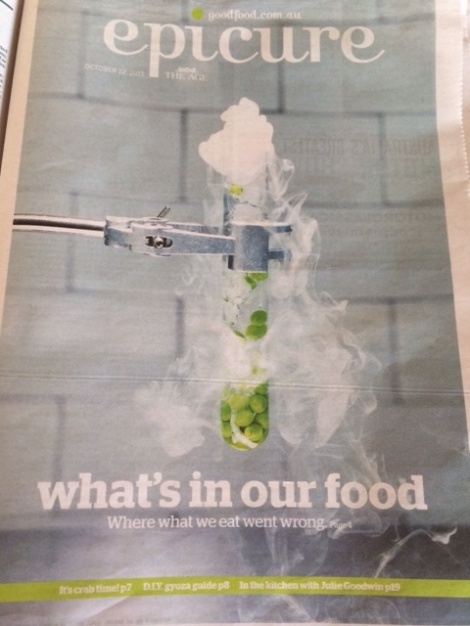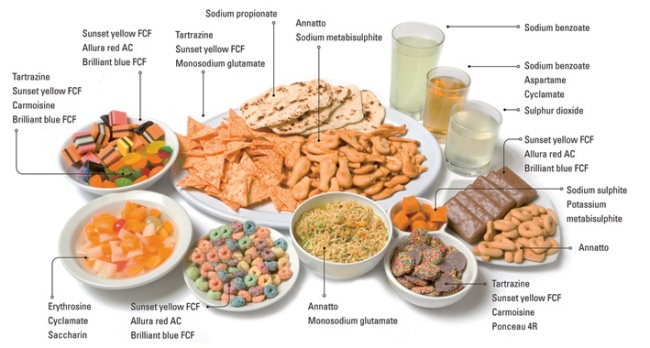 Image courtesy of o2wa.blogspot.com
Image courtesy of o2wa.blogspot.com
I have always made a conscious effort to do the best by my body. The more I learn about good and bad food and where it all comes from, the more I adjust my diet and lifestyle.
My good friend suggested I grab the Epicure on Tuesday October 22…and when I finally devoured its’ pages – BAM!! Shock Horror!!!!?! OMG!? FML!!!!
A summary of this weeks’ Epicure: What’s in our food?
The 15 facts you should all be made aware of:
- Heating a non-stick fry pan on high for 10 minutes can release enough toxic gases to kill a bird (if it were in your kitchen). I give a thumbs up to cast iron pans with enamel finishes. Check out this article.
- It is estimated that 20% of Australian produce ($8 billion) is wasted annually – around 1.5kgs of food per household per day ($8 billion nationally). Approximately one-third of the food produced is thrown out fresh, 27% is leftovers and 9% is frozen food.
- It is estimated that 20-40% of Australian produce does not make it to the supermarket shelves because it is not cosmetically viable (if it’s ugly or bruised…no-one will purchase it).
- Tomatoes, Apples and other produce are often picked months or up to a year in advance and held in Ethylene (petroleum-derived flammable gas) chambers to slow the ripening process and ensure supply all year round.
- L-Cysteine is an amino acid regularly found in packaged foods you’ll find at the supermarket to enhance flavor and as a bread ‘conditioner’…you’re really consuming human hair or duck feathers…have fun with that!
- Many food dyes and enhancers have been found to trigger allergic reactions, food intolerances and even child activity and attentional issues. Note: More than 1000 Australian food products from biscuits to ice-cream contain these additives.
- Palm oil graces our shelves labeled as ‘Vegetable Oil’. It is so high in saturated fat that even lard could be considered a healthier alternative (get rid of it!).
- Australians consume an average of 116 kgs of meat per year (second only to America). To meet consumer demand, chickens can be harvested in 5-8 weeks (half the time of organic chickens) thanks to all of the synthetic antibiotics they are fed…which end up in our bodies. AND chlorine is used to wash the chicken carcasses…even if it says ‘chemical free’ on the advertisement, yummy (not!)
- Free-range eggs…those ‘lucky chickens’ aren’t governed by any laws stipulating what the term actually refers to. Farmers can cram 10,000 to 20,0000 chickens in a hectare.
- Think about food you’re consuming that is not in season…it’s either been stored in cold or gas storage, or imported from countries with different laws governing the food production so you may not know what you’re getting.
- In his book Food Truth Loughnan states that 50,000 tonnes of navel oranges rotted in Australian paddocks and instead concentrate was imported from Brazilian manufacturers while our Australian farmers struggled to make ends meet.
- The Australian Food and Grocery Council says 7000 jobs were lost and 335 businesses had to close their doors or move overseas in 2011-12 due to an increase in food imports from overseas.
- Coles got into trouble with the ACCC for offering ‘fresh baked in store’ bread…when it was really made, par-baked and frozen in Ireland before it was reheated in store.
- Fat-Salt-Sugar…we know the story – avoid processed and packaged food as much as possible, they have been linked to obesity and diseases such as Alzheimer’s disease.
- Plastic not so fantastic. Heating food in any form of plastic can cause it to leach into foods and cause a wide range of healthy problems. Instead look for BPPA free and use glass or homewares (if I use a microwave, it’s a bowl with a plate on top as the lid. It’s a better option).
To summarise I just want to remind you all to make the most informed decision you can.
Yes you only live once, but you want to make it the best and longest life possible. Think about the small decisions that can make a difference here and there – it will all add up.
Image courtesy of choice.com.au

